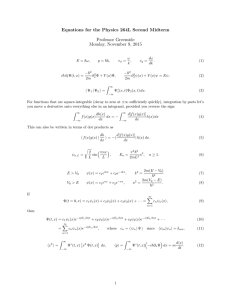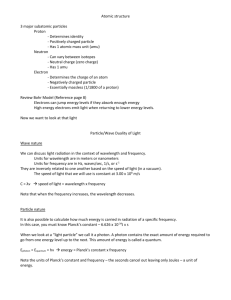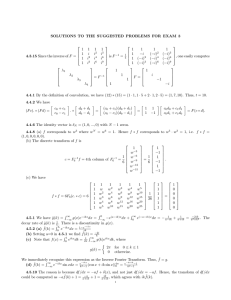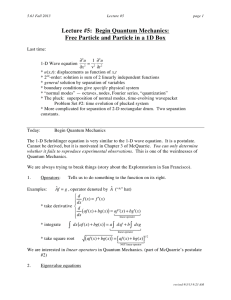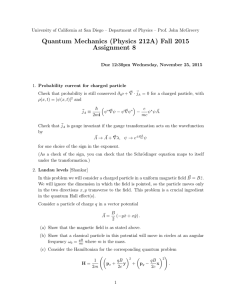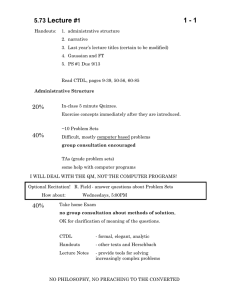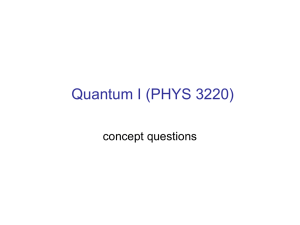Lecture 4 Introduction to Quantum Mechanical Way of Thinking. Today’s Program
advertisement
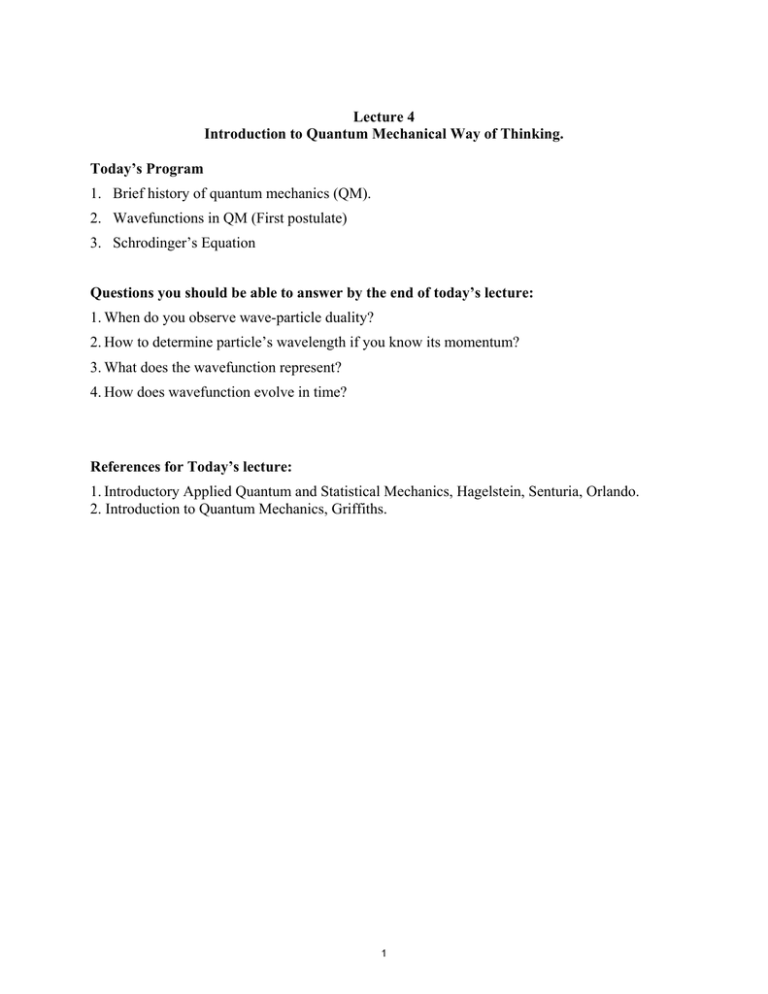
Lecture 4 Introduction to Quantum Mechanical Way of Thinking. Today’s Program 1. Brief history of quantum mechanics (QM). 2. Wavefunctions in QM (First postulate) 3. Schrodinger’s Equation Questions you should be able to answer by the end of today’s lecture: 1. When do you observe wave-particle duality? 2. How to determine particle’s wavelength if you know its momentum? 3. What does the wavefunction represent? 4. How does wavefunction evolve in time? References for Today’s lecture: 1. Introductory Applied Quantum and Statistical Mechanics, Hagelstein, Senturia, Orlando. 2. Introduction to Quantum Mechanics, Griffiths. 1 In the end of 19th century and beginning of the 20th century, scientists were convinced they understood physics. Only a “handful” of experiments remained unexplained. These experiments became a foundation for the new kind of physics, which we now know as Quantum Mechanics. Today a lot of devices (all electronics, all optics) surrounding us are fundamentally quantum mechanical in their design and principles of operation. 1887, Hertz: Photoelectric effect. When illuminated with ultraviolet (UV) light metallic sample emitted electrons. However, the lower frequency (higher wavelength) light did not initiate electron emission even at higher incident light powers. ν I e νo I ν Black Body Spectrum: The physicists were puzzled by the radiation of a black body, as it could not be explained by the Maxwell’s equations. Blackbody curves for various temperatures and comparison with classical theory. (This image is in the public domain. Source: Wikimedia Commons.) For short wavelength (high frequency) limit Wien’s law provided an approximation: const 1 P ,T ~ 5 e T const P , T ~ 3e T For long wavelength (low frequency) Rayleigh-Jeans law provided another approximation: 2 P ,T ~ Const T 4 P ,T ~ Const T 2 Which, if correct, would have resulted in rapid increase of power at short wavelength (high frequency) labeled as “ultraviolet catastrophe”. In 1900, Planck proposed a revolutionary idea: Electromagnetic energy is quantized! There are portions or “quanta” of energy “photons” with energy: 34 2 2 c ch h 6.6310 m kg / s , 1.06 10 34 m 2 kg / s E ph h 2 2 Here h is a Planck’s constant. Using the assumption of energy quantization Planck was able to derive Black Body spectrum: 2hc 2 1 B T 5 hc kBT e 1 3 2h 1 B T 2 h kBT c e 1 Planck’s hypothesis implied that electromagnetic waves were quantized and could be thought of as particles. 1923, Compton’s scattering experiment. Planck’s assumption was further confirmed, when Compton observed that electrons could be deflected by electromagnetic radiation akin to elastic scattering: This experiment established that photons have momentum. From relativistic mechanics and Maxwell’s equations we can then find the relationship between the momentum and energy: E E p 2 c 2 m02 c 4 ; m0 0 p k . Here k is a wavevector. c c But if waves behave like particles, could it be that particles could behave like waves? 1925, Davisson and Germer: Diffraction of electrons on Ni lattice. They found that electrons scattered through the Ni lattice form a diffraction pattern akin to electromagnetic waves scattered on the grating. Electrons behaved like waves! (Despite having a non-zero mass). These experiments were unified by the De Broglie conjecture: All particles are waves and all waves are particles. The wavelength and momentum are related: 3 p k 2 So if all particles are waves, then what are those waves? – Probability! There is a certain probability of finding a particle at a certain point in space and time. First Postulate of Quantum Mechanics: Any quantum mechanical particle or a system in general can be described by a wavefunction wavefunction x, t . (Depending on a system may be in a vector form).�The wavefunctions belong to a state space, which has the properties of a vector space. The general properties of wavefunctions are: (a) single valued (b) square integrable (c) nowhere infinite (at infinity as well as elsewhere) (d) continuous (e) piecewise continuous first derivative We can think of wavefunctions as amplitudes of probability. Then the probability to find a 2 particle at a time t0 at a point r0 is: P r0 , t0 r0 , t0 Since the particle has to be somewhere at all times, and the total probability cannot exceed 1: PAll space 1 r, t d 3r all space Then we can find the particle average position: r all space P r, t rd 3r 2 r, t rd 3r all space Now let’s consider the simplest wavefunction for a particle. In a free space such as vacuum with p no external forces the particle can be approximated as a plane wave: eikxit , where k is the mv 2 p 2 wavevector. Since there are no external forces then the energy of a particle is E . 2 2m How does this wave propagate in time and space? ikxit e ikeikxit x ikxit e i eikxit 2 ikxit 2 ikxi t t e k e x 2 E ikxit e i eikxit 2 ikxit p 2 ikxit t e 2 e x 2 ikxit Eeikxit 2 2 ikxit p 2 ikxit i t e e e 2m x 2 2m E 4 This exercise results in a curious statement about the propagation of particle ~ plane wave in free 2 2 ikxit space: e i eikxit 2 t 2m x In general in the presence of forces in 3D space energy of a particle would be: 2 p E V x, t , which would yield a following equation for the particle described by a 2m wavefunction r, t : 2 2 r, t V x, t x, t i x, t - This equation is known as Schrodinger’s equation 2m t and is usually written in the form: 2 2 V x, t x, t i x, t t 2m 5 MIT OpenCourseWare http://ocw.mit.edu 3.024 Electronic, Optical and Magnetic Properties of Materials Spring 2013 For information about citing these materials or our Terms of Use, visit: http://ocw.mit.edu/terms.
